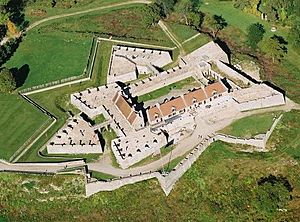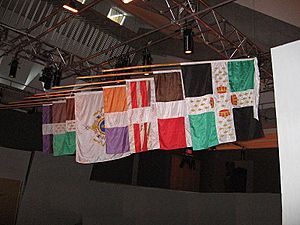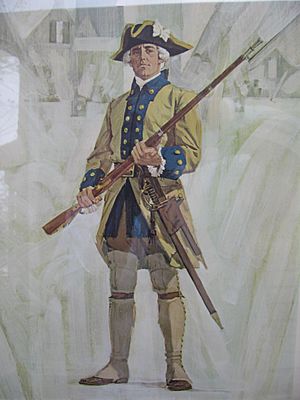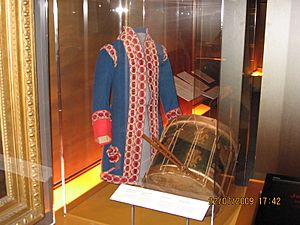Fort Carillon facts for kids
Quick facts for kids Fort Carillon |
|
|---|---|

Fort Carillon (today called Fort Ticonderoga)
|
|
| Coordinates | 43°50′29″N 73°23′17″W / 43.84139°N 73.38806°W |
| Type | Fort |
| Site information | |
| Controlled by | New France |
| Site history | |
| Built | 1755 |
| In use | 1755–1759 |
| Battles/wars | Seven Years War |
| Garrison information | |
| Past commanders |
|
| Garrison |
|
Fort Carillon was an important fort built by the French in North America. It was the first version of what is now known as Fort Ticonderoga. The fort was built by Pierre de Rigaud de Vaudreuil, who was the Governor of New France. Its main purpose was to protect Lake Champlain from a possible attack by the British.
The fort was located about 15 kilometers (9 miles) south of another French fort, Fort Saint-Frédéric. Its job was to stop any British invasion of Canada. It was meant to slow down the enemy long enough for more French soldiers to arrive.
The French King's Engineer, Michel Chartier de Lotbinière, started building Fort Carillon in October 1755. He chose a spot where Lake George (then called Lac Saint Sacrement) meets Lake Champlain. This area was perfect for controlling the waterways.
Contents
- Why Fort Carillon Was Built
- Life at Fort Carillon
- Soldiers at Fort Carillon
- Fort Carillon in 1757: A French Victory
- British Forces Against Fort Carillon
- Preparing for the Battle of Carillon (1758)
- The Battle of Fort Carillon
- British Capture of Fort Carillon
- Images for kids
- Legacy of Fort Carillon
- See also
Why Fort Carillon Was Built
The French needed a strong fort to stop the British from moving north. Fort Saint-Frédéric wasn't strong enough to handle constant British threats. So, Fort Carillon was designed to be a much tougher defense.
Choosing the Best Location
Fort Carillon was placed in a key spot between Lake Champlain and Lake George. This area was a natural battleground. French forces were moving south from Quebec City, and British forces wanted to move north. The fort controlled the southern end of Lake Champlain and the path to the Hudson Valley.
The fort was surrounded by water on three sides. The fourth side had a deep moat for protection. The remaining part was heavily fortified with trenches. These trenches were supported by three cannon batteries. In front of the fort, cut-down trees with sharpened, fire-hardened ends created a strong defense.
Building the Fort's Defenses
Building the fort was slow, but by mid-1756, four strong bastions were in place. These bastions were raised about 5.5 meters (18 feet) high and held cannons. Two bastions, Reine and Germaine, faced away from the lake. They had two demilunes (crescent-shaped outworks) to extend the defenses on the land side.
The other two bastions, Joannes and Languedoc, protected the landing area. They overlooked the lake to the south. The fort's walls were 2.1 meters (7 feet) high and 4.3 meters (14 feet) thick. A sloped area called a glacis and a dry moat (1.5 meters deep and 4.6 meters wide) surrounded the fort. Cannons from Fort St. Frédéric and Montréal were brought in to arm the fort.
By fall 1756, the French realized their chosen spot wasn't perfect. They built a smaller fort, Redoute des Grenadiers, closer to the lake. By January 1757, the fort was still not fully complete. It had earthworks and moats, with 36 cannons ready for an expected British attack.
Life at Fort Carillon
In 1756, the French and Canadian troops started "le Jardin du Roi" (the King's Garden). This garden was on a sandy plain below the fort. It was meant to grow food for the soldiers working on the new fort during the summer.
By 1758, Fort Carillon was more than just a fort. It had a lower town and an upper town. There were also two hospitals, storage buildings (hangars), and barracks for the soldiers. The lower town was shaped like a triangle, with the fort at its northern point. This area had taverns, bakeries, and nine ovens for making bread.
It was important to build cannon batteries for the lower town's defense. Earth dug out for the lower town was used to build up defenses closer to the fort.
On July 22, 1759, the French were ordered to burn the town. Native American allies were surprised that the French would destroy what they had built. Smoke rose from the hospitals, hangars, and barracks. Everything was abandoned as the British army advanced. None of these buildings were ever rebuilt.
Soldiers at Fort Carillon
The soldiers at Fort Carillon came from different groups. They were ready to defend the fort against British attacks.
French Regular Army Troops
The troupes de la terre were professional soldiers from the French Army. They were sent from France to America. These soldiers were well-trained and disciplined. In 1758, Fort Carillon had soldiers from seven different regiments from France.
These regiments included:
- La Reine (345 soldiers)
- Guyenne (470 soldiers)
- Berry (450 soldiers)
- Béarn (410 soldiers)
- La Sarre (460 soldiers)
- Royal Roussillon (480 soldiers)
- Languedoc (426 soldiers)
Most French regular infantry wore white-grey coats. The Régiment de Guyenne and Régiment Berry had red sleeves and vests. Other regiments had blue vests and cuffs. The Régiment de La Sarre had red vests and blue cuffs. French muskets were a bit smaller than British ones.
French Marine Troops and Allies
The Troupes de la Marine were led by Chevalier de Lévis. There were about 150 Canadians with them. Around 250 Native American allies also joined the French at Fort Carillon. In total, there were about 3,500 soldiers.
Cannons on the fort walls were often used. However, during the main Battle of Carillon, most fighting happened further away. This meant soldiers mainly used muskets and bayonets.
Fort Carillon in 1757: A French Victory
In 1757, Louis-Joseph de Montcalm, the French commander at Fort Carillon, decided to attack Fort William Henry. This British fort was at the southern end of Lake George. On August 9, 1757, Montcalm led an army of 7,000 men. This force included French soldiers, Canadian militia, and Native Americans from various tribes.
They successfully captured Fort William Henry. However, after the victory, some Native American allies became very angry. They felt an agreement had been made without their full consent. This led to violent attacks, and between 70 and 150 people were killed. French soldiers then helped the remaining survivors reach Fort Edward to prevent more harm.
Montcalm could have attacked Fort Edward next. Instead, he destroyed Fort William Henry and returned to Fort Carillon. He showed compassion by stopping the violence and helping the survivors. Montcalm knew he had to pull back because his Native American allies were upset and he was running low on supplies.
Food Shortages and British Plans
In 1756, New France had a very bad harvest. Montcalm had to send many Canadian militiamen home to help with farming. But in 1757, the harvest was even worse. Food was scarce, especially around Montreal. People were living on very little bread, and some even ate grass. This made the colony feel very hopeless.
After several French victories in 1757, the British decided to launch a huge attack on Fort Carillon. In June 1758, British General James Abercrombie gathered a large army at Fort William Henry. Their goal was to move north through the Champlain Valley.
On July 6, these forces landed just four miles from Fort Carillon. Montcalm had only arrived at Carillon in late June. He quickly ordered his troops to improve the fort's outer defenses. They built trenches and an abatis (sharpened felled trees) to block the enemy.
General Abercrombie's delay in attacking gave the French time to build these defenses. His second-in-command, Brigadier General George Howe, was killed in a skirmish. This loss deeply affected Abercrombie, which might have made him hesitate to attack right away.
The year 1757 was difficult for the British in North America. To turn things around, British Prime Minister William Pitt appointed General James Wolfe as the new commander of British troops in North America.
British Forces Against Fort Carillon
The British army sent to attack Fort Carillon was made up of two types of soldiers: regular British regiments and provincial regiments.
British Regular Regiments
The British units wore their usual red coats. The only exception was Gage's Light Infantry, who wore grey uniforms. These soldiers were armed with muskets, bayonets, hatchets, or knives. They typically carried 24 rounds of ammunition, but sometimes more.
The British regiments included:
- 27th (Enniskillen) Regiment of Foot
- 42nd (Highland) Regiment of Foot
- 44th Regiment of Foot
- 46th Regiment of Foot
- 55th Regiment of Foot
- 1st and 4th battalions of 60th (Royal American) Regiment
- Gage's Light Infantry
Provincial Regiments
The provincial regiments were made up of soldiers from the American colonies. They usually wore blue uniforms. However, they often changed their uniforms to suit fighting in forests. They could wear different hats and equipment. Rogers' Rangers were a famous group who likely wore their unique green uniforms.
These provincial regiments came from:
Preparing for the Battle of Carillon (1758)
The French government knew the British were sending 8,000 men to North America. But Canada only received 1,800 soldiers, most of whom went to Louisbourg. Because of this, Major-General Louis-Joseph de Montcalm, the French commander, had to rely on Native American allies.
Traditional French allies like the Nipissing, Algonkin, and Abenaki tribes sent about a thousand warriors. To get more fighters, Governor Vaudreuil also recruited a thousand warriors from tribes around the Great Lakes. Managing so many different tribes was hard. There weren't enough interpreters, and old rivalries between tribes needed attention. These Native American allies saw themselves as temporary partners, not subjects of New France. They were often looking for loot.
Even traditional French allies had caused problems before. They had killed wounded British soldiers when the garrison at Oswego surrendered. They even forced the French to buy back some English prisoners.
While Montcalm and Vaudreuil were gathering their army, American rangers tried to stop Native American raids around Fort William Henry. But there weren't enough rangers. In late June, a strong Native American raiding party found that the road between the two forts was mostly unguarded. The French knew the overall situation in June. However, six different scouting parties couldn't get past the Native American screen to learn more details about the large British force at Fort Carillon.
The destruction of Fort William Henry should have made Fort Carillon safe. But the British government made North America a top priority, while France did not. So, another attack on Fort Carillon was planned.
The Battle of Fort Carillon
The British were very worried after losing Fort William Henry. They decided to prepare a huge attack against Fort Carillon. Nearly 16,000 men gathered under General James Abercrombie. This was the largest army ever assembled in North America at that time. The officer in charge of the land attack was Brigadier-General Lord Howe.
On July 8, 1758, General Abercrombie's army attacked Fort Carillon. His force included 6,000 British soldiers and 10,000 colonial soldiers. Their allies, the Mohawks, did not take part in the battle. Fort Carillon was defended by Louis-Joseph de Montcalm with only 3,600 soldiers. This included 400 Canadians and 300 Abenaki warriors.
Abercrombie wanted a quick victory. He decided to attack the fort directly. However, the French had very strong defenses. Even though the fort was still being built, the French dug deep trenches. These trenches were protected by three cannon batteries. Montcalm also ordered sharpened trees to be placed in front of the fort. These trees were tangled with branches and spikes, making a formidable barrier.
Part of the French forces were hidden in the nearby forest. The fort was surrounded by water on three sides. The back half was protected by a moat. This left only one main way to approach the fort.
Abercrombie could have tried to go around the French defenses. But he wanted a fast win. His lieutenant told him it would be possible to take the French by a direct assault. So, Abercrombie chose a massive frontal attack.
The French defenses were very well prepared. The British faced heavy cannon fire. The French soldiers were lined up in three rows. As one row fired, another reloaded, allowing for continuous, strong fire.
British soldiers had to climb over each other to reach the top of the trenches. This made it easy for the French to push them back. Only once did the British manage to break through the French defenses. But they were quickly driven back by a bayonet charge. The British tried to take the fort many times but were always pushed back by the French artillery.
Abercrombie sent his men to attack the fort repeatedly. He lost 551 soldiers, 1,356 were wounded, and 77 went missing. The British retreated to Fort William Henry. The French and Canadians had 104 killed and 273 wounded. This was a major victory for the French.
British Capture of Fort Carillon
Jeffery Amherst, now the commander of British forces in America, led 12,000 soldiers. He prepared to attack Fort Carillon on July 21, 1759. On July 22 and 23, the French commander Bourlamaque left the fort with 3,600 men. He sent 400 soldiers to burn the two hospitals, storage buildings, barracks, and the lower part of the town.
For four days, from July 23 to 26, the British bombed the fort. They used artillery placed near where Captain Hébécourt and his men were defending. On July 26, the French left the fort at 10 PM. At midnight, explosives blew up most of the fort. The French then moved to Fort Saint Frédéric. Bourlamaque did the same thing at Fort Saint Frédéric on July 31.
After that, the French moved to Isle-aux-Noix. Amherst decided not to attack them there. He preferred to strengthen his forces in the lower Lake Champlain area. As they left, the French used explosives to destroy what they could of Fort Carillon. They also damaged or dumped any cannons they couldn't take with them.
The British moved into the fort on July 27. They worked in 1759 and 1760 to repair and improve the fort. They renamed it Fort Ticonderoga. However, the fort did not see any more major battles in the war. After the war, the British kept a small number of troops there. But they let the fort fall apart. In 1773, Colonel Frederick Haldimand, who was in command, wrote that the fort was in "ruinous condition."
Images for kids
Legacy of Fort Carillon
Fort Carillon, the Battle of Carillon, and the Flag of Carillon are very important to French Canadians and the people of Quebec. The Flag of Quebec was even designed after the Carillon flag. The fort and its history bring honor to Canada and the province of Quebec.
See also
 In Spanish: Fort Carillon para niños
In Spanish: Fort Carillon para niños







